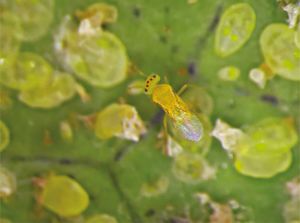Difference between revisions of "Eretmocerus mundus (parasitoid)"
From Pestinfo-Wiki
| (2 intermediate revisions by the same user not shown) | |||
| Line 1: | Line 1: | ||
| − | {{ | + | {{TaxLinks|LnkEretmocerus}} |
| − | {{ | + | {{LiteratureDBY|{{PAGENAME}}|521|browse,Ccountrylnk,PhostsP}} |
| − | <font color="#008000">'''''Eretmocerus mundus'' (parasitoid)'''</font> Mercet, 1931 | + | [[File:Eretmocerus mundus JournIPM 2017.jpg|300px|thumb|''Eretmocerus mundus'' (click on image to enlarge it)<br />Author(s): Alex Protasov<br />Source: [https://doi.org/10.1093/jipm/pmx021 Journal of Integrated Pest Management (2017), 8 (1 - 29)]]] |
| − | is a parasitoid of whiteflies. | + | <font color="#008000">'''''Eretmocerus mundus'' (parasitoid)'''</font> Mercet, 1931 |
| + | |||
| + | The wasp is native to the Mediterranean regions and a parasitoid of whiteflies. It is, for example very effective against ''[[Bemisia tabaci]]'' and its different biotypes. Females lay eggs under the whitefly nymphs. The hatching larvae penetrate the host and develop inside. ''E. mundus'' is commercial available and widely used in greenhouses. | ||
[[Category:Eretmocerus (genus - parasitoids)]] | [[Category:Eretmocerus (genus - parasitoids)]] | ||
Latest revision as of 16:05, 3 December 2022
| Literature database |
|---|
| 89 articles sorted by: |
| • year (descending) |
| • research topics |
| • countries/regions |
| • list of pest species |

Eretmocerus mundus (click on image to enlarge it)
Author(s): Alex Protasov
Source: Journal of Integrated Pest Management (2017), 8 (1 - 29)
Author(s): Alex Protasov
Source: Journal of Integrated Pest Management (2017), 8 (1 - 29)
Eretmocerus mundus (parasitoid) Mercet, 1931
The wasp is native to the Mediterranean regions and a parasitoid of whiteflies. It is, for example very effective against Bemisia tabaci and its different biotypes. Females lay eggs under the whitefly nymphs. The hatching larvae penetrate the host and develop inside. E. mundus is commercial available and widely used in greenhouses.